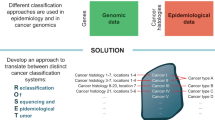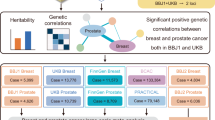Abstract
Cancer genetics has for many years focused on mutational events that have their primary effect within the cancer cell. Recently that focus has widened, with evidence of the importance of epigenetic events and of cellular interactions in cancer development. The role of common genetic variation in determining the range of individual susceptibility within the population is increasingly recognized, and will be addressed using information from the Human Genome Project. These new research directions will highlight determinants of cancer that lie outside the cancer cell, suggest new targets for intervention, and inform the design of strategies for prevention in groups at increased risk.
This is a preview of subscription content, access via your institution
Access options
Subscribe to this journal
Receive 51 print issues and online access
$199.00 per year
only $3.90 per issue
Buy this article
- Purchase on Springer Link
- Instant access to full article PDF
Prices may be subject to local taxes which are calculated during checkout

Similar content being viewed by others
References
Nowell, P. C. The clonal evolution of tumour cell populations. Science 194, 23–28 (1974).
Hanahan, D. & Weinberg, R. A. The hallmarks of cancer. Cell 100, 57–70 (2000).
Liotta, L. & Petricoin, E. Molecular profiling of human cancers. Nature Rev. Genet. 1, 48–56 (2000).
Baylin, S. B. & Herman, J. G. DNA methylation in tumorigenesis. Trends Genet. 16, 168–174 (2000).
Rothman, N. et al. The use of common genetic polymorphisms to enhance the epidemiologic study of environmental carcinogens. Biochem. Biophys. Acta. 1471, C1–C10 (2001).
Olden, K. & Wilson, S. Environmental health and genomics: visions and implications. Nature Rev. Genet. 1, 149–153 (2000).
Tlsty, T. D. & Hein, P. W. Know thy neighbor: stromal cells can contribute oncogenic signals. Curr. Opin. Genet. Dev. 11, 54–59 (1998).
Risch, A. Hormonal etiology of epithelial ovarian cancer, with a hypothesis concerning the role of androgens and progesterone. J. Natl Cancer Inst. 90, 1774–1768 (1998).
Yu, H. & Rohan, T. Role of the insulin-like growth factor family in cancer development and progression. J. Natl Cancer Inst. 92, 1472–1489 (2000).
Easton, D. F., Ponder, M. A., Huson, S. M. & Ponder, B. A. J. An analysis of variation in expression of neurofibromatosis (NF) type 1 (NF1): evidence for modifying genes. Am. J. Hum. Genet. 53, 305–313 (1993).
Nadeau, J. H. Modifier genes in mice and humans. Nature Rev. Genet. 2, 165–174 (2001).
Knudson, A. G. Mutation and cancer: statistical study of retinoblastoma. Proc. Natl Acad. Sci. USA 68, 820–823 (1971).
Harris, H. The analysis of malignancy by cell fusion: the position in 1988. Cancer Res. 48, 3302–3306 (1988).
Park, M. in The Genetic Basis of Human Cancer (eds Vogelstein, B. & Kinzler, K. W.) 205–228 (McGraw Hill, New York, 1998).
Bishop, J. M. Enemies within: the genesis of retrovirus oncogenes. Cell 23, 5–6 (1981).
Parada, L. P., Tabin, C. J., Shih, C. & Weinberg, R. A. Human EJ bladder carcinoma oncogene is a homologue of Harvey Sarcoma virus ras gene. Nature 297, 474–477 (1982).
Rabbitts, T. H. Chromosomal translocations in human cancer. Nature 372, 143–149 (1994).
Brodeur, G. M. & Hogarty, M. D. in The Genetic Basis of Human Cancer (eds Vogelstein, B. & Kinzler, K. W.) 161–172 (McGraw Hill, New York, 1998).
Mitelman, F., Mertens, F. & Johansson, B. A breakpoint map of recurrent chromosomal rearrangements in human neoplasia. Nature Genet. 13, 417–474 (1997).
Gray, J. W. & Collins, C. Genome changes and gene expression in human solid tumours. Carcinogenesis 21, 443–452 (2000).
The BAC Resource Consortium. Integration of cytogenetic landmarks into the draft sequence of the human genome. Nature 409, 953–957 (2001).
DePinho, R. A. The age of cancer. Nature 408, 248–254 (2000).
Comings, D. A general theory of carcinogenesis. Proc. Natl Cancer Inst. 70, 3324–3328 (1973).
Cavenee, W. K. et al. Expression of recessive alleles by chromosomal mechanisms in retinoblastoma. Nature 305, 779–781 (1983).
Weinberg, R. A. Tumor suppressor genes. Science 254, 1138–1146 (1991).
Fearon, E. R. in: The Genetic Basis of Human Cancer (eds Vogelstein, B. & Kinzler, K. W.) 229–236 (McGraw Hill, New York, 1998).
Haber, D. & Harlow, E. Tumor suppressor genes: evolving definitions in the genomic age. Nature Genet. 16, 320–322 (1997).
Kinzler, K. W. & Vogelstein, B. Gatekeepers and caretakers. Nature 386, 761–763 (1997).
Orborne, R. J. & Hamshere, M. G. A genome-wide map showing common regions of loss of heterozygosity/allelic imbalance in breast cancer. Cancer Res. 60, 3706–3712 (2000).
Faro, M. L. et al. The murine gene p27KIP1 is haploinsufficient for tumour suppression. Nature 396, 177–180 (1998).
Rainier, S. et al. Relaxation of imprinted genes in human cancer. Nature 362, 747–749 (1993).
Cui, H. et al. Loss of imprinting in normal tissue of colorectal cancer patients with microsatellite instability. Nature Med. 4, 1276–1280 (1998).
Herman, J. G. et al. Incidence and functional consequences of hMLH1 promoter hypermethylation in colorectal carcinoma. Proc. Natl Cancer Inst. 95, 6870–6875 (1998).
Chen, R. Z., Pettersson, U., Beard, C., Jackson-Crushy, L. & Jaenisch, R. DNA hypomethylation leads to elevated mutation rates. Nature 395, 89–93 (1998).
Jackson-Crushy, L. . et al. Loss of genomic methylation causes p53-dependent apoptosis and epigenetic deregulation. Nature Genet. 27, 31–39 (2001).
Cormier, R. J. & Dove, W. F. Dnmtn/+ reduces the net growth rate and multiplicity of intestinal adenomas in C57BL/6-multiple intestinal neoplasia (Min)/+ mice. Cancer Res. 60, 3965–3970 (2000).
Issa, J.-P. J. et al. Methylation of the oestrogen receptor CpG island links ageing and neoplasia in human colon. Nature Genet. 7, 536–540 (1994).
Feinberg, A. P. Methylation meets genomics. Nature Genet. 27, 9–10 (2001).
Sapienza, C. Genome imprinting, cellular mosaicism and carcinogenesis. Mol. Carcinogenesis 3, 118–124 (1990).
Engler, P. et al. A strain-specific modifier on mouse chromosome 4 controls the methylation of independent transgene loci. Cell 65, 939–947 (1991).
Silver, A. J. & White, R. Inheritance of allelic blueprints for methylation patterns. Cell 54, 145–152 (1988).
Renan, M. J. How many mutations are required for tumorigenesis? Implications from human cancer data. Mol. Carcinogenesis 7, 139–146 (1993).
Suzuki, S. et al. An approach to analysis of large scale correlations between genome changes and clinical endpoints in ovarian cancer. Cancer Res. 60, 5382–5385 (2000).
Neal, D. E. & Donovan, J. L. Prostate cancer: to screen or not to screen? Lancet Oncol. 1, 17–24 (2000).
El-Omar, E. M. et al. Interleukin-1 polymorphisms associated with increased risk of gastric cancer. Nature 404, 398–402 (2000).
Williams, J. A. Single nucleotide polymorphisms, metabolic activation and environmental carcinogenesis: why molecular epidemiologists should think about enzyme expression. Carcinogenesis 22, 209–214 (2001).
Ames, B. N. & Gold, L. S. Too many rodent carcinogens: mitogenesis increases mutagenesis. Science 249, 970–971 (1990).
Cordon-Carlo C. & Prives C. At the crossroads of inflammation and tumorigenesis. J. Exp. Med. 190, 1367–1370 (1999).
Lowenfils, A. B. et al. Hereditary pancreatitis and the risk of pancreatic cancer. J. Natl Cancer Inst. 89, 442–446 (1997).
Olumi, A. F. et al. Carcinoma-associated fibroblasts direct tumor progression of initiated human prostatic epithelium. Cancer Res. 59, 5002–5011 (1999).
Barcellos-Hoff, M. H. & Ravani, S. A. Irradiated mammary gland stroma promotes the expression of tumorigenic potential by unirradiated epithelial cells. Cancer Res. 60, 1254–1260 (2000).
Sternlicht, M. D. et al. The stromal protease MMP3/Stromelysin-1 promotes mammary carcinogenesis. Cell 96, 137–146 (1999).
Coussens, L. M., Tinhl, C. C., Hanahan, D. & Werb, Z. MMP-9 supplied by bone marrow-derived cells contributes to skin carcinogenesis. Cell 103, 481–490 (2000).
Thomas, M. V. et al. A prospective study of endogenous serum hormone concentrations in post-menopausal women on the island of Guernsey. Br. J. Cancer 76, 401–405 (1997).
Jernstrom, H. et al. Genetic and non-genetic factors associated with variation of plasma levels of insulin-like growth factor-1 and insulin-like growth factor binding protein-3 in healthy pre-menopausal women. Cancer Epidemiol. Biomarkers Prev. (in the press).
Peto, J. in Cancer Incidence in Defined Populations Banbury Report 4 (eds Cairns, J., Lyon, J. L. & Skolnick, M.) (Cold Spring Harbor, New York, 1980).
Ponder, B. A. J. Inherited predisposition to cancer. Trends Genet. 6, 213–218 (1990).
Vogelstein, B. & Kinzler, K. W. (eds) The Genetic Basis of Human Cancer (McGraw Hill, New York, 1998).
Klausner, R. D. Studying cancer in the mouse. Oncogene 18, 5249–5252 (1999).
Ponder, B. A. J. Genetic testing for cancer risk. Science 278, 1050–1054 (1997).
Chen, F. et al. Germline mutations in the Von Hippel Lindau disease tumour suppressor gene: correlation with phenotype. Hum. Mutat. 5, 66–75 (1995).
Kinzler, K. W. & Vogelstein, B. in The Genetic Basis of Human Cancer (eds Vogelstein, B. & Kinzler, K. W.) 565–587 (McGraw Hill, New York, 1998).
Eng. C. & The International RET Mutation Consortium. The relationship between specific RET protooncogene mutations and disease phenotype in multiple endocrine neoplasia type 2. J. Am. Med. Assoc. 276, 1575–1579 (1996).
Halberg, R. B. et al. Tumorigenesis in the multiple intestinal neoplasia mouse: redundancy of negative regulations and specificity of modifiers. Proc. Natl Acad. Sci. USA 97, 3461–3466 (2000).
The Anglian Breast Cancer Study Group. Prevalence of BRCA1 and BRCA2 mutations in a large population based series of breast cancer cases. Br. J Cancer 83, 1301–1308 (2000).
Dunning, A. M. et al. A systematic review of genetic polymorphisms and breast cancer risk. Cancer Epidemiol. Biomarkers Prev. 8, 843–854 (1999).
Chakravarti, A. ... to a future of genetic medicine. Nature 409, 822–823 (2001).
Cardon, L. R. & Bell, J. I. Association study designs for complex diseases. Nature Rev. Genet. 2, 91–99 (2001).
The International SNP Map Working Group. A map of human genome sequence variation containing 1.42 million single nucleotide polymorphisms. Nature 409, 928–933 (2001).
Balmain, A. & Nagase, H. Cancer resistance genes in mice: models for the study of tumour modifiers. Trends Genet. 14, 139–144 (1998).
Mackay, T. F. C. Quantitation trait loci in Drosophila. Nature Rev. Genet. 2, 11–20 (2001).
Bell, J. The new genetics in clinical practice. Br. Med. J. 316, 618–620 (1998).
Holtzman, N. A. & Marteau, T. M. Will genetics revolutionize medicine? New Engl. J. Med. 343, 141–144 (2000).
Acknowledgements
I apologize that space has restricted the topics and the references that could be included. I thank D. Easton for advice on the figure in Box 1, and several colleagues for helpful suggestions. B.A.J.P. is a Gibb Fellow of The Cancer Research Campaign (CRC).
Author information
Authors and Affiliations
Rights and permissions
About this article
Cite this article
Ponder, B. Cancer genetics. Nature 411, 336–341 (2001). https://doi.org/10.1038/35077207
Published:
Issue Date:
DOI: https://doi.org/10.1038/35077207
This article is cited by
-
A truncated nuclear norm and graph-Laplacian regularized low-rank representation method for tumor clustering and gene selection
BMC Bioinformatics (2021)
-
Association of lncRNA PRNCR1 polymorphisms with cancer susceptibility: a meta-analysis of the current literature
Journal of Genetics (2021)
-
LncRNA PLAC2 upregulates miR-663 to downregulate TGF-β1 and suppress bladder cancer cell migration and invasion
BMC Urology (2020)
-
GWAS in cancer: progress and challenges
Molecular Genetics and Genomics (2020)
-
Transcriptome profiling revealed multiple genes and ECM-receptor interaction pathways that may be associated with breast cancer
Cellular & Molecular Biology Letters (2019)
Comments
By submitting a comment you agree to abide by our Terms and Community Guidelines. If you find something abusive or that does not comply with our terms or guidelines please flag it as inappropriate.



